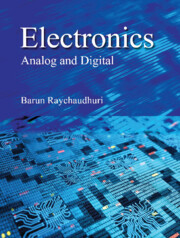Book contents
Summary
This chapter introduces the types of semiconductors and their electrical properties. The origin of two types of charge carriers, namely electrons and holes in semiconductors are explained. The related theoretical concepts of energy band, Fermi energy and effective mass are introduced. The carrier transport in semiconductors causing drift and diffusion currents are discussed. Two important experimental techniques, namely Hall Effect and four-probe resistivity measurement are deliberated.
Crystalline Solids
A broad field of studies, known as condensed matter physics encompasses the macroscopic and microscopic physical properties of matter, mainly in the solid and liquid phases, being ‘condensed’ due to the electromagnetic forces between atoms. A part of this is solid state physics that studies the atomic level and bulk level properties of matter in its solid state. A solid is distinguished from liquid or gas by its definite shape and rigidity. This is because of the atoms or the molecules of a solid being closely packed and strongly bound. However, the atoms in a solid may or may not be in regular arrangement, which determines whether or not the solid is crystalline.
A semiconductor is generally a solid material having electrical conductivity level somewhere between that of conductors (e.g. metals) and insulators (e.g. ceramics). The conducting properties of semiconductors can be altered by application of external electrical fields, light and heat and by a process of incorporating impurities, known as doping. Devices made from semiconductors, such as diode, transistor and logic gates are the basic building blocks for modern electronic circuits. Before going through the properties of semiconductors, it is reasonable to get a brief idea on the fundamental properties of a crystalline solid.
A solid is called crystalline, if the atoms and the molecules in it are organized in symmetric arrays in three dimensions. A definite grouping of atoms is repeated periodically in three dimensions. If the crystal structure is perfect and the same regular arrangement is extended throughout the entire solid, it is called single crystal and if the periodicity is found to be intermittent and confined within a small region, it is called polycrystalline material. Solids not having such regular atomic arrangement are termed as amorphous.
- Type
- Chapter
- Information
- Electronics , pp. 20 - 60Publisher: Cambridge University PressPrint publication year: 2023



